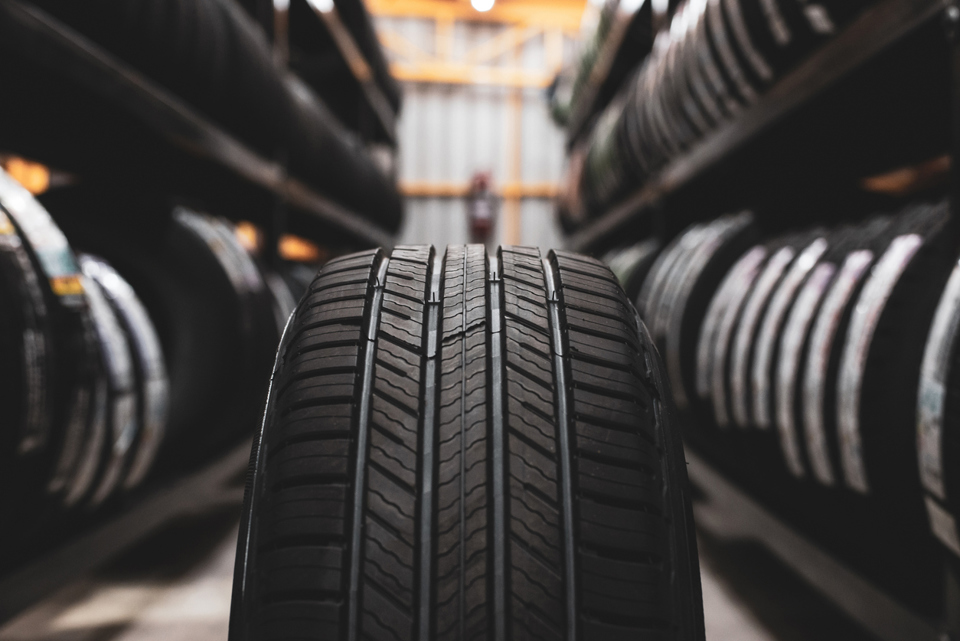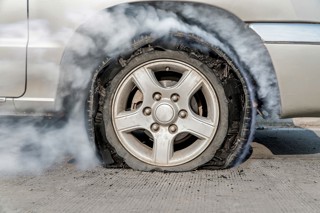This feature originally appeared in the October 2020 edition of Fleet News. Read the digital issue of the magazine.
As the only part of a vehicle that touches the road, it is universally accepted that tyres have a critical influence on safety.
But industry studies show they are also responsible for around 20% of the CO2 emitted – and fuel used – by a car or van.
This is because when the tyre comes into contact with the road, it deforms which makes it heat up and some of the energy which would otherwise have been used to move the vehicle is lost, says Michelin. This phenomena is known as rolling resistance.
“Reducing this heat build-up makes it possible to lower fuel consumption and, consequently, greenhouse gas emissions,” it adds.
Tyres also have an environmental impact through the raw materials needed to manufacture them, as well as the microplastics created when they wear (see below).
This an area which fleets are increasingly taking notice of, says Dan Joyce, fleet director at Kwik Fit.
“We’re starting to see customers with energy-efficient tyre policies,” he adds. “About 90% of our customer base has a premium tyre policy and, within that, specifying tyres with green credentials is starting to become more common.”
However, Kwik Fit’s experience of fleet customers specifically requesting energy-efficient tyres has not been repeated all across the industry.
Martin Towers, sales director for Micheldever Fleet Services, says: “We are not necessarily seeing conscious changes in the way that contract hire companies purchase their tyres. However, there is a definite sub-conscious change with the demand being driven by the end user and fleet managers where there is a specific need.
“With the manufacturers pushing increasing numbers of tyres with lower rolling resistance and higher efficiency ratings into the supply chain, they will, inevitably, be fitted to a wider range of vehicles.
“If they are on the shelf and available, they will be used. Again, not the result of a conscious decision to fit those type of tyres, but one that is driven by supply and availability.”
Tyre choice
When seeking a tyre that will minimise a fleet’s environmental impact, there should ultimately be two goals, says David Morris, sales channel manager at Goodyear.
“The first is to choose a tyre that will last as long as possible before needing to be replaced, while the second is to fit a product that, throughout its lifetime, will actually improve the overall efficiency of the vehicle,” he adds.
“One of the best ways to achieve this, where possible, is to choose a tyre that has been designed in such a way that will minimise rolling resistance.
“Low rolling resistance tyres are designed to reduce the amount of energy lost as they roll, decreasing the effort required and therefore improving the vehicle’s overall fuel efficiency as a result.”
Fleets can easily identify low rolling resistance tyres by using the European Union’s tyre labelling scheme.
This ranks rolling resistance – as well as wet grip and noise – from A (best) to G (worst). Continental says using tyres classed as ‘A’ can reduce fuel consumption and CO2 emissions by as much as 9% compared with ‘G’ tyres.
“The tyre labelling is a good starting point for consumers and fleet managers to say ‘okay, which tyre is going to give me decent fuel consumption’,” says Chris Smith, managing director at Michelin UK.
“However, the labelling measures rolling resistance when the tyre is brand new. As it wears down, its characteristics will change so it’s important for fleet managers to read the reviews and do their research to look at how that tyre performs through its entire life.
“One of the critical factors in terms of the environmental impact of a tyre is the longer the tyre lasts and as its tread depth reduces, the more fuel efficient it should be: a tyre with 3mm of tread is more fuel efficient than the same tyre with 7mm.
“If the tyre wears out really quickly and you’ve got to put a new one on, then you’re back to its original performance. But if you’ve got a tyre that stays, for example, at 1.6mm, 2.6mm or 3.6mm for a longer period of time, you’re getting the benefit of that lower fuel consumption and CO2 for a longer period.”
Sustainable strategy
Consideration should also be given to more than just the choice of tyre, says a spokesperson for Continental’s Technical Services. “A fleet manager should consider the tyre manufacturer’s whole strategy and not just the tyre,” he adds.
“Factors such as their sustainability policies and automotive expertise are important.”
Manufacturers such as Continental, Goodyear and Michelin are spending millions of pounds to research the development of environmentally-friendly raw materials, with synthetic rubber, carbon black, reinforcing fibres and rubber compounding agents – all materials used in the construction of a tyre – all singled out as primary targets.
By next year Continental, for example, will have invested almost €35 million (£32m) in its Taraxagum project which is looking at providing sufficient natural rubber from dandelion crops grown near its factories to reduce the environmental impact of importing it from subtropical countries.
Last year, it launched its first production tyre using the technology – the Urban Taraxagum bicycle tyre – and has also started to manufacture test tyres for cars and trucks.
“It is clear there is a long road ahead before this technology can be mainstream,” says Continental. “However, it may well be the start of a very bright sustainable future for tyres.”
Smith says Michelin has reduced its tyres’ rolling resistance on average by 1% every year for the past 10 years, while Goodyear has the goal of reducing rolling resistance by 40% and tyre weight by 9% by 2025 compared with 2005 standards.
In 2012, its scientists began developing a tread compound in which soybean oil replaced petroleum-derived oil to provide a more sustainable and renewable product. It aims to use this to replace petroleum-derived oils entirely in its tyres by 2040.
In-life management
While product choice can have a major affect on the environmental impact of an organisation’s tyres, there is also plenty a fleet decision-maker can do with the tyres fitted to vehicles.
“The key to reducing the environmental impact of a tyre throughout its life is to regularly maintain it,” says Morris. “Simple measures like checking tyre pressures are crucial. Keeping the tyre at the manufacturer’s designated pressure will not only enhance the rolling resistance and therefore consume less fuel, but also ensures a more even wear across the surface of the tread.
“A regularly under- or over-inflated tyre will cause excessive wear either around the edges or in the centre of the tyre, often causing it to need replacing sooner than if the tread was kept at its optimal pressure.”
Incorrectly inflated tyres can also impact handling, stopping distances and braking grip. Continental recommends fleet managers should ensure tyre pressures are checked regularly, while vehicle maintenance “is another consideration when fleet managers are looking at the environmental impact of their tyres”.
The Continental spokesperson adds: “An example is issues with steering geometry. Geometry issues tend to arise from situations such as driving over potholes or on an uneven road and by excessive wear to steering or suspension components.
“This can lead to wheel misalignment and, as a result, uneven tyre wear. This uneven wear has an impact on not only the safety of tyres, but the fuel efficiency.”
Poor alignment could make a 5% or 6% difference to fuel efficiency, says Smith. “Alignment is something which generally would only be checked on a car when the tyres are changed, but some van and car fleets do look at it more regularly than that because it does have a big impact on fuel consumption,” he adds.
Morris recommends fleets have a tyre management policy to reinforce the importance of regular tyre care.
“Generally speaking, fleets will often have company car and driver policies, but tyre management policies aren’t as common as they should be,” he says.
“Ideally though, they should be afforded the same care and attention as any other health and safety document, with managers working in consultation with either a tyre manufacturer or respected supplier to provide one.
“It doesn’t need to include a lot of information, but it should form part and parcel of a standard company document.”
Many fleets have policies where tyres are replaced when the tread depth reaches either 3mm or 2mm, but Smith says organisations can reduce their environmental impact by running them to the legal limit of 1.6mm.
“Michelin tyres have been designed to be used down to 1.6mm,” he says. “I appreciate some fleets don’t see their vehicles often, so running them to exactly 1.6mm is not always possible, but it’s certainly not our position to advocate taking the tyres off early.
“To reiterate the point, a tyre with 2mm tread is more fuel efficient than the same tyre at 3mm or 4mm, so you don’t want to waste that fuel-efficient state.
“You’ve also got the raw material that’s gone into making that tyre and, therefore, by removing it too early you’re simply wasting the natural resources and materials that are in a tyre that’s designed to be used to 1.6mm.”
In 2017, an Ernst & Young report commissioned by Michelin found that changing tyres at 3mm instead of 1.6mm would cost European Union drivers an extra €6.9 billion (£6.2bn) a year in unnecessary tyre purchases and additional fuel consumption.
It found that changing tyres too early would result in 128 million additional tyres being used a year in Europe, which would cause nine million tonnes of additional CO2 emissions every year.
Work still needed on the fine detail
Tyre particulates and microplastics – the tiny debris which comes off a tyre when it wears – have become an increasing focus in recent years.
A UK Government-funded research project published this summer suggests particles released from vehicle tyres could be a significant and previously largely unrecorded source of microplastics in the marine environment.
The Defra-funded study, led by the University of Plymouth, found tyre particulates can be transported directly
to the ocean through the atmosphere or carried by rainwater into rivers and sewers, where they can pass through the water treatment process.
Researchers estimate this could place around 100 million sq m of the UK’s river network – and more than 50m sq m of estuarine and coastal waters – at risk of contamination by tyre particles.
Professor Richard Thompson, head of the International Marine Litter Research Unit, who directed the study, says: “Scientists have long suspected that tyre debris is posing a hidden threat to the marine environment.
“However, there have been few studies measuring abundance in aquatic environments.
“This study gives us a real insight into the importance of tyre wear as a source of microplastics. However, there are still many unknowns, and compared with other forms of microplastics we know relatively little about tyre wear particles.
“It is important to work together with industry and policymakers to identify potential solutions which may include changes in behaviour, changes in product design and waste management.”
Tyre companies are also looking at this issue. Since 2006, the Tyre Industry Project – which involves 11 leading manufacturers – has been dedicated to researching the potential effects of tyre material on health and the environment.
Various scientific publications in journals have emerged from these activities.




















Login to comment
Comments
No comments have been made yet.